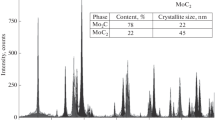Summary
It was shown that reaction of carbon monoxide with chlorides of Group VI metals in presence of triethylaluminum or diisobutylaluminum hydride gives carbonyls of Group VI metals.
Similar content being viewed by others
Literature cited
A. Job and A. Cassal, C. r. 183, 392 (1926).
W. Hieber, and E. Romberg, Z. anorg. Chem. 221, 321 (1935).
M. Windsor and Q. Blanchard, J. Am. Chem. Soc. 56, 823 (1934).
B. B. Owen, J. English, H. G. Cassidy and C. V. Dundon, J. Am. Chem. Soc. 69, 1723 (1947).
K. Ziegler, H. G. Gellert, K. Zosel, W. Lehmkuhl and W. Pfohl, Ang. Chem. 67, 424 (1955).
Author information
Authors and Affiliations
Rights and permissions
About this article
Cite this article
Zakharkin, L.I., Gavrilenko, V.V. & Okhlobystin, O.I. Action of triethyaluminum and diisobutylaluminum hydride on chlorides of Group VI metals in presence of carbon monoxide. Synthesis of chromium, molybdenum, and tungsten Carbonyls. Russ Chem Bull 7, 92–94 (1958). https://doi.org/10.1007/BF01170869
Received:
Issue Date:
DOI: https://doi.org/10.1007/BF01170869



